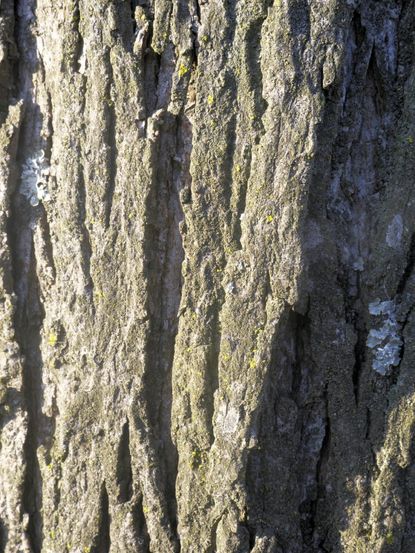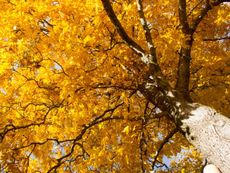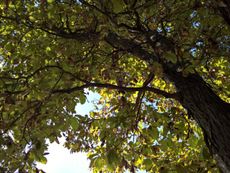Shagbark Hickory Tree Info: Caring For Shagbark Hickory Trees


You won’t easily mistake a shagbark hickory tree (Carya ovata) for any other tree. Its bark is the silver-white color of birch bark but shagbark hickory bark hangs in long, loose strips, making the trunk look shaggy. Caring for these tough, drought-resistant native trees isn't difficult. Read on for more shagbark hickory tree info.
Shagbark Hickory Tree Info
Shagbark hickory trees are native to the eastern and midwestern sections of the country and are usually found in mixed forests with oaks and pines. Slow-growing giants, they can rise to a mature height of over 100 feet (30.5 m.). Shagbark hickory tree info suggests that these trees are very long-lived. They are considered mature at the age of 40 years, and some 300 year old trees continue to produce fruits with seeds. This tree is a relative of the walnut, and its fruit is edible and delicious. It is eaten by humans and wildlife alike, including woodpeckers, blue jays, squirrels, chipmunks, raccoons, turkeys, grosbeaks, and nuthatches. The outer husk cracks to reveal the nut within.
What are Shagbark Trees Used For?
These hickories are interesting specimen trees because of the unusual shagbark hickory bark and their delicious nuts. However, they grow so slowly that they are rarely used in landscaping. You might ask, then, what are shagbark trees used for? They are most often used for their strong wood. The wood of the shagbark hickory is prized for its strength, toughness, and flexibility. It is used for shovel handles and sports equipment as well as firewood. As firewood, it adds a delicious flavor to smoked meats.
Planting Shagbark Hickory Trees
If you decide to start planting shagbark hickory trees, expect it to be the work of a lifetime. If you start from a very young seedling, remember that the trees don’t produce nuts for the first four decades of their lives. Nor is it easy to transplant this tree once it is older. It quickly develops a strong taproot that goes straight down into the ground. This taproot helps it survive droughts but makes transplant difficult. Plant your tree in well-drained soil. It grows in USDA plant hardiness zones 4 through 8 and prefers fertile, rich soil. However, the tree can tolerate almost any type of soil. Caring for your shagbark hickory tree is a snap since it is resistant to insect pests and diseases. It requires no fertilizer and little water. Just make sure to allow it a large enough site to grow to maturity.
Gardening tips, videos, info and more delivered right to your inbox!
Sign up for the Gardening Know How newsletter today and receive a free download of our most popular eBook "How to Grow Delicious Tomatoes."

Teo Spengler has been gardening for 30 years. She is a docent at the San Francisco Botanical Garden. Her passion is trees, 250 of which she has planted on her land in France.
-
 Clever Vertical Vegetable Garden Ideas For Small Spaces – 7 Ways To Save Space
Clever Vertical Vegetable Garden Ideas For Small Spaces – 7 Ways To Save SpaceShort on garden space? Learn some vegetable garden ideas for small spaces that are fun and easy.
By Mary Ellen Ellis
-
 26 Different Types Of Orchids – With Pictures & Information
26 Different Types Of Orchids – With Pictures & InformationDiscover stunning orchid types to grow in your home and garden – from easy beginner varieties to rare and exotic species that are the preserve of experts.
By Melanie Griffiths
-
 Pignut Tree Characteristics And Care Instructions
Pignut Tree Characteristics And Care InstructionsWith a common name like “pignut hickory,” this is a tree that grabs your attention. And rightly so. Read on for more pignut tree info.
By Teo Spengler
-
 Hickory Nut Tree Pruning: Tips On Pruning Hickory Trees
Hickory Nut Tree Pruning: Tips On Pruning Hickory TreesPruning hickory trees is not really necessary for fruit production once the trees are mature but it is an important part of training the plant as it grows. To learn more about hickory tree pruning, click the article that follows.
By Bonnie L. Grant
-
 Hickory Nut Uses: Tips For Harvesting Hickory Nuts
Hickory Nut Uses: Tips For Harvesting Hickory NutsHickory nut harvesting is a fun, family activity that will provide you with a supply of these high-protein nuts to last through the winter. Learn more about harvesting hickory nuts in this article so you can reap all their benefits.
By Bonnie L. Grant
-
 About Hickory Trees - Tips For Growing A Hickory Tree
About Hickory Trees - Tips For Growing A Hickory TreeHickories are an asset to large landscapes and open areas, though their large size makes them out of scale for urban gardens. read this article to learn more about growing a hickory tree.
By Jackie Carroll